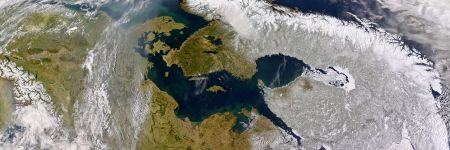| Background > The Baltic Sea

The Baltic Sea is unique little ocean. It is one of the most intensely poulated semi-enclosed seas, and it is among the best studied ocean areas in the world. Only the very narrow Danish Straits allow a water exchange with the North Atlantic Ocean. This and the fact that its sea floor is characterized by a sequence deep basins separated by shallow ridges make the Baltic Sea quite vulnerable to oxygen deficiencies in the deep basins, with considerable consequences for marine life and the biogechemistry of the Baltic Sea. This is due to natural geographical conditions, but it is aggravated by human activities such as eutrophication.
The hydrography of Baltic Sea shows strong horizontal and vertical gradients. Ocean salinity is relatively constant all over the oceans between 33 and 36, but in the Baltic Sea, it ranges from 30 in the Skagerrak to about 2 in the northernmost part. There is also a distinct horizontal salinity gradient, with high values in deep water, and low values at the surface. Due to the large range of salinities, the number of species in the Baltic Sea is lower than other boral (i.e. being in a northern climate zone) sea areas. Oxygen is often depleted in some deep basins, leading to the unique biogechemical properties of the Baltic Sea. Biological transformations in the anoxic water body and at its boundaries to the overlying oxygenated water are mostly responsible for the unusual nutrient budget, leading to extensive bluegreen algae blooms.
|

